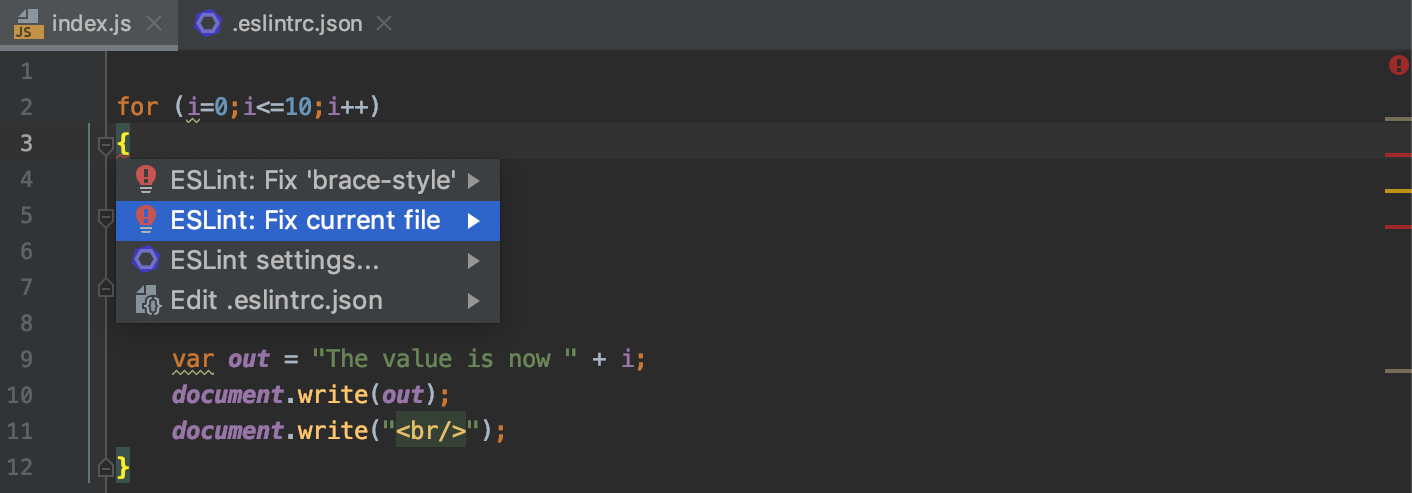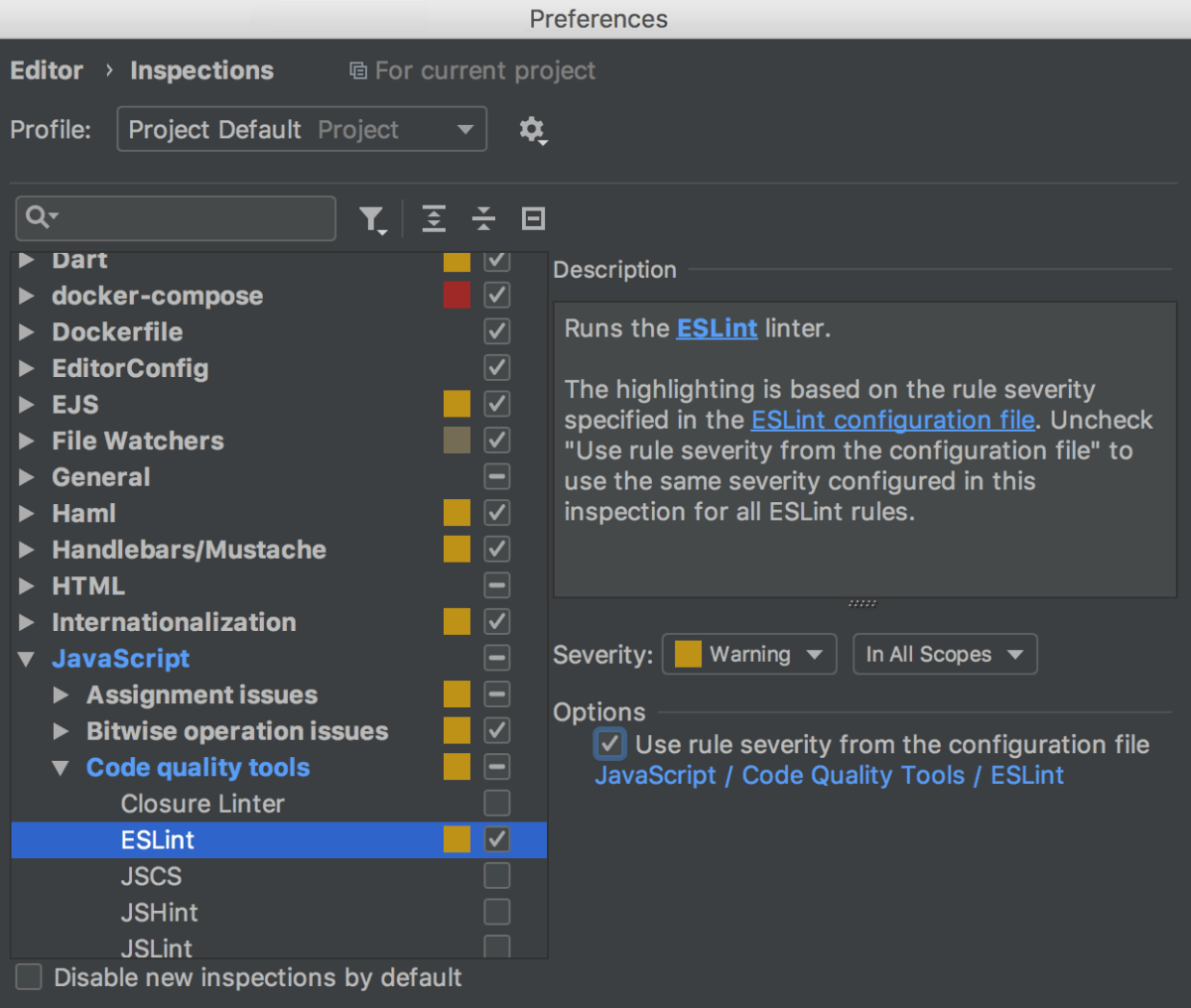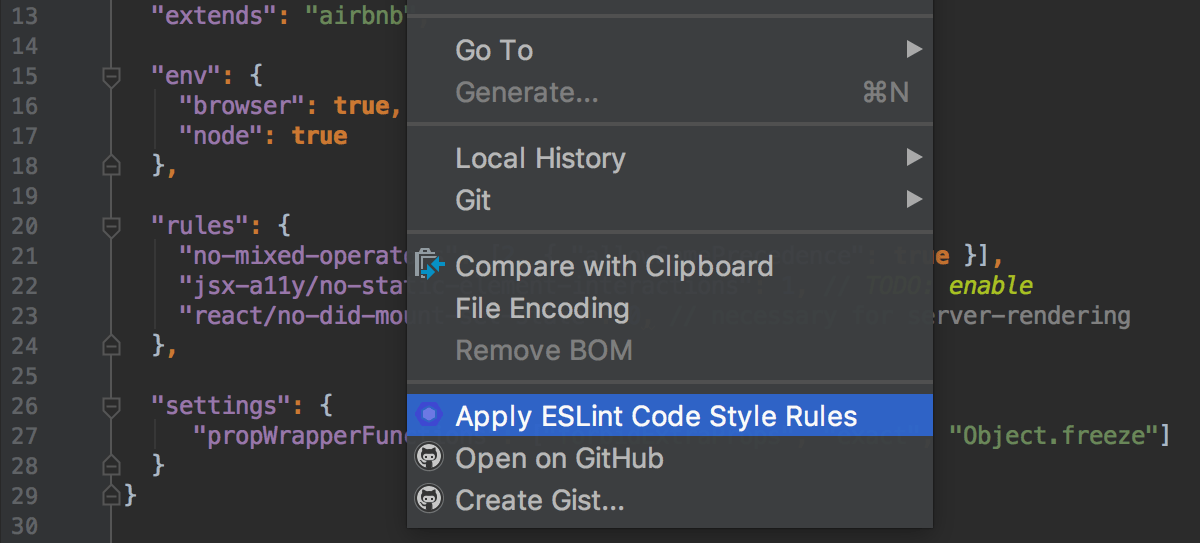ESLint
WebStorm integrates with ESLint which brings a wide range of linting rules that can also be extended with plugins. WebStorm shows warnings and errors reported by ESLint right in the editor, as you type. With ESLint, you can also use JavaScript Standard Style.
To view the description of a problem, hover over the highlighted code.

To resolve the detected problem, click ESLint: Fix '<rule name>' or press Shift+Alt+Enter.
To resolve all the detected problems in the current file, click More actions (Alt+Enter) and select from the list.

To fix problems on the fly, configure ESLint as a custom file watcher, see Detecting and fixing problems on save.
By default, WebStorm marks detected problems based on the severity levels from the ESLint configuration. See Configuring ESLint highlighting to learn how to override these settings.
Installing ESLint
-
Make sure you have Node.js on your computer.
-
In the embedded Terminal (Alt+F12), type one of the following commands:
-
npm install eslint -gfor global installation. -
npm install eslint --save-devto install ESLint as a development dependency.
-
-
Optionally, install additional plugins, for example, eslint-plugin-react to lint React applications.
Activating and configuring ESLint in WebStorm
By default, WebStorm uses the ESLint package from the project node_modules folder and the .eslint.* configuration file from the folder where the current file is stored. If no .eslint.* is found in the current file folder, WebStorm will look for one in its parent folders up to the project root.
If you have several package.json files with ESLint listed as a dependency, WebStorm starts a separate process for each package.json and processes everything below it. This lets you apply a specific ESLint version or a specific set of plugins to each path in a monorepo or a project with multiple ESLint configurations.
This behavior is default in all new WebStorm projects. To enable it in a previously created project, go to in the Settings/Preferences dialog Ctrl+Alt+S and select the Automatic ESLint configuration option.
You can also configure ESLint manually to use a custom ESLint package and configuration.
-
Select the Manual Configuration option to use a custom ESLint package and configuration.
-
In the Node Interpreter field, specify the path to Node.js. If you followed the standard installation procedure, WebStorm detects the path and fills in the field itself.
-
In the ESLint Package field, specify the location of the eslint or standard package.
-
Choose the configuration to use.
-
With Automatic search, WebStorm looks for a .eslintrc file or tries to detect a configuration defined under
eslintConfigin a package.json. WebStorm first looks for a .eslintrc or package.json in the folder with the file to be linted, then in its parent folder, and so on up to the project root. -
Choose Configuration File to use a custom file and specify the file location in the Path field.
Learn more about configuring ESLint from the ESLint official website.
-
-
Optionally:
-
In the Extra ESLint Options field, specify additional command-line options to run ESLint with, use spaces as separators.
Learn more about ESLint CLI options from the ESLint official website.
-
In the Additional Rules Directory field, specify the location of the files with additional code verification rules. These rules will be applied after the rules from .eslintrc or the above specified custom configuration file and accordingly will override them.
-
Detecting and fixing problems on save
With WebStorm, you can configure ESLint to wake up every time a JavaScript file is updated and consequently auto saved. As a result, any detected problem is fixed automatically right away.
Click
 on the toolbar and select <custom> from the Choose Template list.
on the toolbar and select <custom> from the Choose Template list. -
In the New Watcher dialog that opens, specify the following:
-
In the File type field, specify in what files you want ESLint to wake up on any change. You can select Any if you do not want to restrict the use of ESLint to any file type.
-
Choose the scope in which you want to use ESLint, for example, All Places or Project Files.
-
In the Program field, specify the location of the eslint or standard package. Note that you can use macros, for example:
$ProjectFileDir$/node_modules/.bin/eslint -
In the Arguments field, type:
--fix $FilePath$ -
In the Output paths to refresh field, type:
$FilePath$ Assign the new watcher a name, for example, eslint.
Learn more from File Watchers.
-
Configuring highlighting for ESLint
By default, WebStorm marks the detected errors and warnings based on the severity levels from the ESLint configuration. For example, errors are highlighted with a red squiggly line, while warnings are marked with a yellow background. See Code inspections and Change inspection severity for details.
Change the severity level of a rule in the ESLint configuration
-
In .eslintrc or under
eslintConfigin package.json, locate the rule you want to edit and set its ID to1warnor to2error.Learn more from the ESLint official website.
You can override the severities from the ESLint configuration so that WebStorm ignores them and shows everything reported by the linter as errors, warnings, or in a custom color.
Ignore the severity levels from the configuration
-
In the Settings/Preferences dialog Ctrl+Alt+S, select . The Inspections page opens.
-
In the central pane, go to JavaScript | Code quality tools | ESLint.
-
In the right-hand pane, clear the Use rule severity from the configuration file checkbox and select the severity level to use instead of the default one.

Importing code style from ESLint
You can import some of the ESLint code style rules to the WebStorm JavaScript code style settings. That enables WebStorm to use more accurate code style options for your project when auto-completing, generating, or refactoring the code or adding import statements. When you use the Reformat action, WebStorm will then no longer break properly formatted code from the ESLint perspective.
WebStorm understands ESLint configurations in all official formats: .eslintrc JSON files, package.json files with the eslintConfig field, as well as JavaScript and YAML configuration files.
When you open your project for the first time, WebStorm imports the code style from the project ESLint configuration automatically.
-
If your ESLint configuration is updated (manually or from your version control), open it in the editor and choose Apply ESLint Code Style Rules from the context menu.

Alternatively, just answer Yes to the "Apply code style from ESLint?" question on top of the file.

The list of applied rules is shown in the Event log tool window:

Using JavaScript Standard Style
You can set JavaScript Standard Style as default JavaScript code style for your application so its main rules are applied when you type the code or reformat it. Since Standard is based on ESLint, you can also use Standard via the WebStorm ESLint integration.
Install JavaScript Standard
-
In the embedded Terminal (Alt+F12), type:
npm install standard --save-devLearn more from the JavaScript Standard Style official website.
Enable linting with Standard via ESLint
If you open a project where standard is listed in the project's package.json file, WebStorm enables linting with Standard automatically.
Set the JavaScript Standard Style as default
-
On the Code Style. JavaScript page that opens, click Set from, and then select Predefined Style | JavaScript Standard Style. The style will replace your current scheme.
Linting TypeScript code with ESLint
WebStorm highlights errors reported by ESLint in .ts and .tsx files when @typescript-eslint/parser is set as a parser in your project ESLint configuration. Learn more from the readme file in the typescript-eslint repo.
Use ESLint for TypeScript in a new project
-
In the embedded Terminal (Alt+F12), type:
npm install @typescript-eslint/parser @typescript-eslint/eslint-plugin --save-dev -
In the .eslintrc configuration file or under
eslintConfigin package.json, add:{ "parser": "@typescript-eslint/parser", "plugins": ["@typescript-eslint"], "extends": ["plugin:@typescript-eslint/recommended"] }
Suppress linting TypeScript code with ESLint
-
If you are already using
@typescript-eslint/parserbut you do not want to check TypeScript code with ESLint, add .ts or .tsx to the .eslintignore file.
ESLint 4.0
If you are using previous versions of ESLint, you have to install babel-eslint, typescript-eslint-parser, or eslint-plugin-typescript because ESLint 4.0 and earlier do not support scoped packages.
Use babel-eslint
-
In the embedded Terminal (Alt+F12), type:
npm install eslint babel-eslint --save-devLearn more about installation and versions compatibility from the babel-eslint official documentation.
-
In the .eslintrc configuration file or under
eslintConfigin package.json, add:{ "parser":"babel-eslint" }
Use typescript-eslint-parser
-
In the embedded Terminal (Alt+F12), type:
npm install typescript-eslint-parser --save-devLearn more from the typescript-eslint-parser official documentation.
-
In the .eslintrc configuration file or under
eslintConfigin package.json, add:{ "parser":"typescript-eslint-parser" }